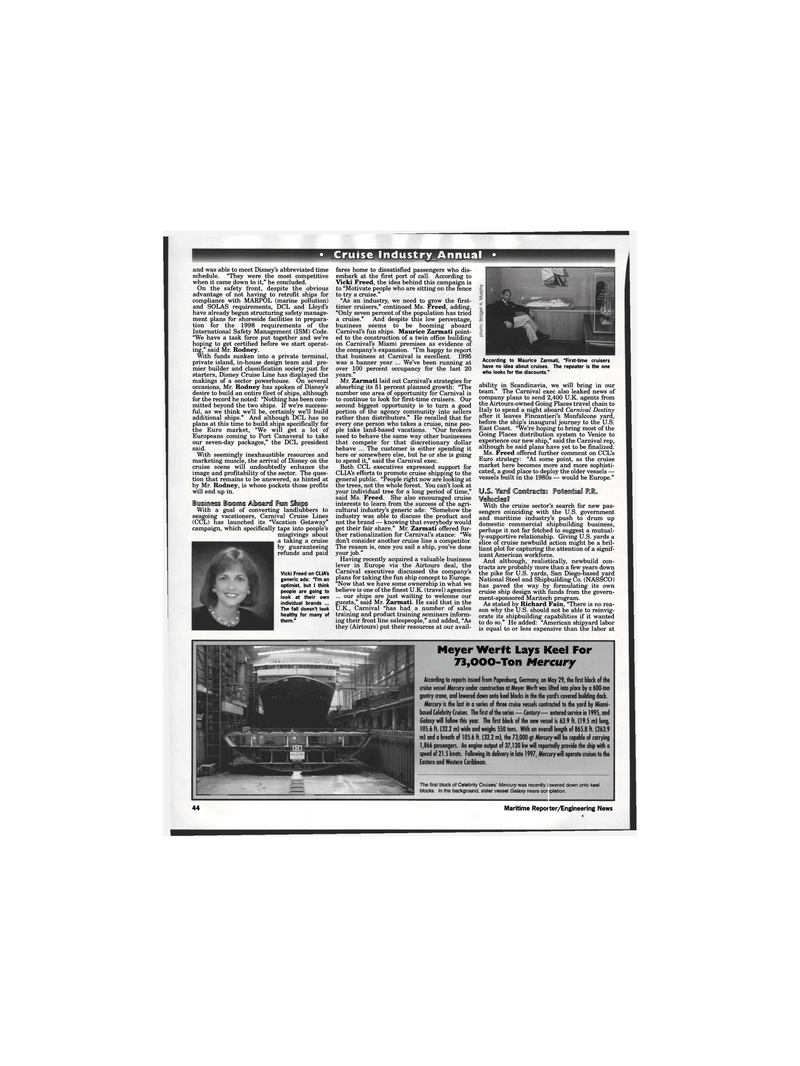
Page 42: of Maritime Reporter Magazine (July 1996)
Read this page in Pdf, Flash or Html5 edition of July 1996 Maritime Reporter Magazine
• Cruise Industry Annual • and was able to meet Disney's abbreviated time schedule. "They were the most competitive when it came down to it," he concluded.
On the safety front, despite the obvious advantage of not having to retrofit ships for compliance with MARPOL (marine pollution) and SOLAS requirements, DCL and Lloyd's have already begun structuring safety manage- ment plans for shoreside facilities in prepara- tion for the 1998 requirements of the
International Safety Management (ISM) Code. "We have a task force put together and we're hoping to get certified before we start operat- ing," said Mr. Rodney.
With funds sunken into a private terminal, private island, in-house design team and pre- mier builder and classification society just for starters, Disney Cruise Line has displayed the makings of a sector powerhouse. On several occasions, Mr. Rodney has spoken of Disney's desire to build an entire fleet of ships, although for the record he noted: "Nothing has been com- mitted beyond the two ships. If we're success- ful, as we think we'll be, certainly we'll build additional ships." And although DCL has no plans at this time to build ships specifically for the Euro market, "We will get a lot of
Europeans coming to Port Canaveral to take our seven-day packages," the DCL president said.
With seemingly inexhaustible resources and marketing muscle, the arrival of Disney on the cruise scene will undoubtedly enhance the image and profitability of the sector. The ques- tion that remains to be answered, as hinted at by Mr. Rodney, is whose pockets those profits will end up in. fares home to dissatisfied passengers who dis- embark at the first port of call. According to
Vicki Freed, the idea behind this campaign is to "Motivate people who are sitting on the fence to try a cruise." "As an industry, we need to grow the first- timer cruisers," continued Ms. Freed, adding, "Only seven percent of the population has tried a cruise." And despite this low percentage, business seems to be booming aboard
Carnival's fun ships. Maurice Zarmati point- ed to the construction of a twin office building on Carnival's Miami premises as evidence of the company's expansion. "I'm happy to report that business at Carnival is excellent. 1995 was a banner year ... We've been running at over 100 percent occupancy for the last 20 years."
Mr. Zarmati laid out Carnival's strategies for absorbing its 51 percent planned growth: "The number one area of opportunity for Carnival is to continue to look for first-time cruisers. Our second biggest opportunity is to turn a good portion of the agency community into sellers rather than distributors." He recalled that for every one person who takes a cruise, nine peo- ple take land-based vacations. "Our brokers need to behave the same way other businesses that compete for that discretionary dollar behave ... The customer is either spending it here or somewhere else, but he or she is going to spend it," said the Carnival exec.
Both CCL executives expressed support for
CLIA's efforts to promote cruise shipping to the general public. "People right now are looking at the trees, not the whole forest. You can't look at your individual tree for a long period of time," said Ms. Freed. She also encouraged cruise interests to learn from the success of the agri- cultural industry's generic ads: "Somehow the industry was able to discuss the product and not the brand — knowing that everybody would get their fair share." Mr. Zarmati offered fur- ther rationalization for Carnival's stance: "We don't consider another cruise line a competitor.
The reason is, once you sail a ship, you've done your job."
Having recently acquired a valuable business lever in Europe via the Airtours deal, the
Carnival executives discussed the company's plans for taking the fun ship concept to Europe. "Now that we have some ownership in what we believe is one of the finest U.K. (travel) agencies ... our ships are just waiting to welcome our guests," said Mr. Zarmati. He said that in the
U.K., Carnival "has had a number of sales training and product training seminars inform- ing their front line salespeople," and added, "As they (Airtours) put their resources at our avail-
According to Maurice Zarmati, "First-time cruisers have no idea about cruises. The repeater is the one who looks for the discounts." ability in Scandinavia, we. will bring in our team." The Carnival exec also leaked news of company plans to send 2,400 U.K. agents from the Airtours-owned Going Places travel chain to
Italy to spend a night aboard Carnival Destiny after it leaves Fincantieri's Monfalcone yard, before the ship's inaugural journey to the U.S.
East Coast. "We're hoping to bring most of the
Going Places distribution system to Venice to experience our new ship," said the Carnival rep, although he said plans have yet to be finalized.
Ms. Freed offered further comment on CCL's
Euro strategy: "At some point, as the cruise market here becomes more and more sophisti- cated, a good place to deploy the older vessels — vessels built in the 1980s — would be Europe."
Uo§o Vardl c©m)tactt§s PtoterottoaD [ROL
Vdhodes?
With the cruise sector's search for new pas- sengers coinciding with the U.S. government and maritime industry's push to drum up domestic commercial shipbuilding business, perhaps it not far fetched to suggest a mutual- ly-supportive relationship. Giving U.S. yards a slice of cruise newbuild action might be a bril- liant plot for capturing the attention of a signif- icant American workforce.
And although, realistically, newbuild con- tracts are probably more than a few years down the pike for U.S. yards, San Diego-based yard
National Steel and Shipbuilding Co. (NASSCO) has paved the way by formulating its own cruise ship design with funds from the govern- ment-sponsored Maritech program.
As stated by Richard Fain, "There is no rea- son why the U.S. should not be able to reinvig- orate its shipbuilding capabilities if it wanted to do so." He added: "American shipyard labor is equal to or less expensive than the labor at
The first block of Celebrity Cruises' Mercury was recently bwered down onto keel blocks. In the background, sister vessel Galaxy nears cor ipletion.
Meyer Werft Lays Keel For 73,000-Ton Mercury
According to reports issued from Papenburg, Germany, on May 29, ihe first block of the cruise vessel Mercury under construction at Meyer Werft was lifted into place by a 600-ton gantry crane, and lowered down onto keel blocks in the the yard's covered building dock.
Mercury is the last in a series of three cruise vessels contracted to the yard by Miami- based Celebrity Cruises. The first of the series — Century— entered service in 1995, and
Go/oxy will follow this year. The first block of the new vessel is 63.9 ft. (19.5 m) long, 105.6 ft. (32.2 m) wide and weighs 550 tons. With an overall length of 865.8 ft. (263.9 m) and a breath of 105.6 ft. (32.2 m), the 73,000-gt Mercury will be capable of carrying 1,866 passengers. An engine output of 37,130 kw will reportedly provide the ship with a speed of 21.5 knots. Following its delivery in late 1997, Mercury will operate cruises to the
Eastern and Western Caribbean. ®gjisoiid®§§ isMDinrDS Mwrairdl Fqjiijd Slhops
With a goal of converting landlubbers to seagoing vacationers, Carnival Cruise Lines (CCL) has launched its "Vacation Getaway" campaign, which specifically taps into people's misgivings about a taking a cruise by guaranteeing refunds and paid
Vicki Freed on CLIA's generic ads: "I'm an optimist, but I think people are going to look at their own individual brands ...
The fall doesn't look healthy for many of them." 44 Maritime Repot ter/Engineering News

 41
41

 43
43
